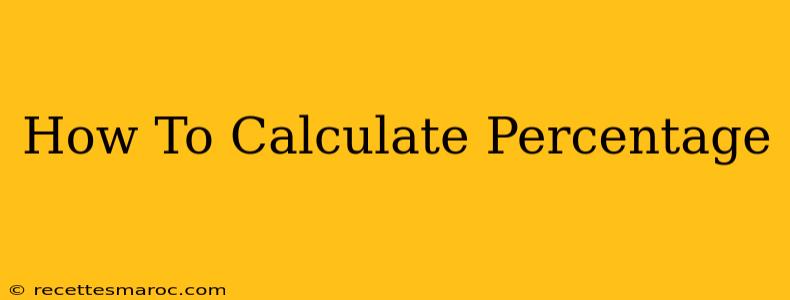Percentages are used everywhere, from calculating discounts in stores to understanding financial reports. Knowing how to calculate percentages is a fundamental skill. This guide will break down the process, making it easy to understand, no matter your math background.
Understanding Percentages
A percentage is simply a fraction out of 100. The word "percent" literally means "per hundred." So, 50% means 50 out of 100, or 50/100, which simplifies to 1/2.
Calculating Percentages: The Basic Formula
The fundamental formula for calculating a percentage is:
(Part / Whole) * 100% = Percentage
Let's break this down:
- Part: This is the number you want to express as a percentage of the whole.
- Whole: This is the total number.
- Percentage: This is the result of your calculation, expressed as a percentage.
Example Scenarios and Step-by-Step Solutions
Let's look at some common examples to solidify your understanding.
Example 1: Calculating a Percentage of a Number
Problem: What is 20% of 80?
Solution:
-
Identify the parts: The part is 20 (the percentage), and the whole is 80.
-
Apply the formula: (20/100) * 80 = 16
Answer: 20% of 80 is 16.
Example 2: Calculating the Percentage One Number Represents of Another
Problem: You scored 45 out of 50 on a test. What is your percentage score?
Solution:
-
Identify the parts: The part is 45 (your score), and the whole is 50 (the total possible score).
-
Apply the formula: (45/50) * 100% = 90%
Answer: Your percentage score is 90%.
Example 3: Finding the Whole When You Know the Percentage and the Part
Problem: 25% of a number is 15. What is the number?
Solution: This requires a slight rearrangement of the formula:
-
Set up the equation: 25/100 * x = 15 (where 'x' represents the unknown whole number)
-
Solve for x: x = (15 * 100) / 25 = 60
Answer: The number is 60.
Tips and Tricks for Percentage Calculations
-
Use a calculator: For larger numbers or more complex calculations, a calculator can significantly speed up the process. Many calculators have a percentage button (%) that can simplify the calculation.
-
Convert percentages to decimals: Dividing the percentage by 100 converts it to a decimal, which can sometimes make calculations easier. For example, 20% is equivalent to 0.20.
-
Practice regularly: The more you practice, the more comfortable and confident you will become with percentage calculations.
Beyond the Basics: Advanced Percentage Applications
The basic percentage formula can be adapted to solve a wide variety of problems, including:
- Calculating percentage increase or decrease: Used to track changes in values over time.
- Calculating profit margins: Used in business to determine profitability.
- Calculating tax rates: Understanding how taxes are applied to income or purchases.
- Understanding discounts and markups: Essential for shopping and business decisions.
Mastering percentage calculations is a valuable skill applicable to numerous aspects of life. With consistent practice and understanding of the core formula, you can confidently tackle any percentage problem that comes your way.

